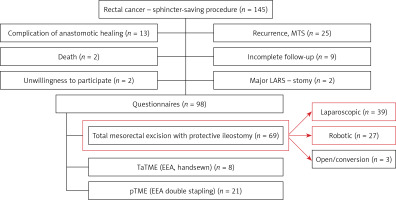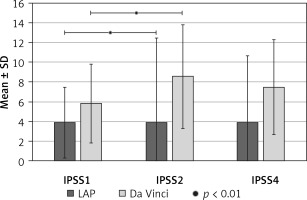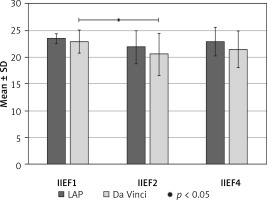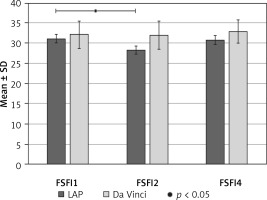Introduction
Over the last decades there have been important changes in the management of rectal cancer [1]. Total mesorectal excision (TME), the procedure that was first described by Professor Heald, remains generally accepted as the gold standard for treatment of rectal cancer located in the mid and low rectum [2]. Surgery is still the only treatment offering a chance of cure [3].
Over the last decades minimally invasive techniques have widely penetrated the surgical field and we can also see an increasing emphasis on sphincter-sparing surgery [4]. Robotic rectal surgery is an evolution of traditional laparoscopy. The most recent Xi robotic system includes several important technological improvements and therefore could overcome some limitations of the laparoscopic approach [5, 6].
Outcomes for rectal cancer surgery have improved significantly, with increasing survival and lower recurrence rates, specifically local recurrence. Oncological outcomes have improved secondary to increased surveillance, application of neoadjuvant chemoradiation therapy for locally advanced disease and advances in surgical techniques [1, 7]. Due to the higher survival rate, there is a higher number of patients with long-term survival and good functional outcomes and quality of life are becoming increasingly important [8].
Quality of life is considered an important outcome in addition to traditional end points, such as oncological outcomes and complication rates. Nevertheless, functional disorders after rectal cancer surgery are underestimated although they are a significant quality of life factor. In fact, regardless of the possibility of recovering from cancer, patients are often frightened by the surgery itself: rectal cancer surgery is generally considered as highly destructive due to the risk of definitive colostomy, incontinence, sexual and urinary dysfunctions, alteration of body anatomy, and overall poor quality of life [9]. On the other hand, incontinence and urogenital dysfunction may be troublesome to manage for surgeons when they occur [10].
Aim
The aim of the present study was to investigate preoperative and postoperative urogenital functions over time after robotic and laparoscopic TME in patients with mid or low rectal cancer.
Material and methods
This is a retrospective single-centre study on prospective collected data of patients with histologically proven adenocarcinoma of the mid or low rectum (lesions up to 12 cm from the anal verge) who underwent laparoscopic or robotic low anterior resection with total mesorectal excision.
Exclusion criteria from this study were emergency procedure, tumour duplicity, open surgery or conversion, abdominoperineal resection or Hartmann’s procedure, distant metastases preoperatively or recurrence within the follow-up period. Other reasons for exclusion were unwillingness to participate, incomplete data, losses to follow-up or anastomotic complication with ostomy. The flowchart is shown in Figure 1.
The study was approved by the institutional ethics committee.
Preoperative staging included total colonoscopy with biopsy, abdominopelvic and thoracic computed tomography (CT), pelvic magnetic resonance imaging (MRI) and positron emission tomography or endoanal ultrasound if needed. All patients were discussed at a multidisciplinary board meeting. Long-course preoperative chemoradiotherapy (external beam radiation with a total dose of 50.4 Gy, delivered in 28 fractions with capecitabine orally) was considered for locally advanced disease (T3, T4 and node-positive disease). Radical curative surgery was performed within 8–10 weeks of the end of neoadjuvant therapy. Adjuvant chemotherapy was standard treatment for stage III and for stage II with some high risk factor.
For each patient we obtained the following data: age, sex, body mass index (BMI), ASA classification, neoadjuvant or adjuvant therapy, tumour location, TNM classification (8th edition), operative time, blood loss, hospital stay, postoperative complications, 30-day mortality and time to ileostomy reversal.
Surgical technique
Surgeons involved in the operations were well trained in minimally invasive surgery. The robotic system they used was the fourth generation of the da Vinci system, the da Vinci Xi (Intuitive Surgical, Sunnyvale, CA, USA), which is a four-arm system with four robotic ports in a straight line oblique to the midline, and one assistant port. All patients in the robotic group underwent a full robotic procedure.
In all cases, both approaches were carried out using the same surgical steps and principles. Every operation started in a Trendelenburg position with exploration of the abdominal cavity and intraoperative ultrasonography of the liver. The surgical technique included medial to lateral dissection with high ligation of the inferior mesenteric artery and with ligation of the inferior mesenteric vein at the level of the inferior margin of the pancreas using clips, and complete mobilization of the splenic flexure and left colon. TME started with dissection at the sacral promontory in the posterior avascular plane with identification and preservation of the right and left hypogastric nerve and sacral vessels, as caudally as possible to the endopelvic fascia. The anterior plane was achieved by dissection anterior to Denonvilliers’ fascia with its division at the lower margin of the seminal vesicles. Dissection was completed at the lateral sides and including the transection of the anococcygeal ligament at the posterior side for better mobilization of the rectum.
After completion of TME, the rectum was divided with the laparoscopic or robotic stapling device. The robot was disengaged and all anastomoses were performed under laparoscopic control using a double-stapling technique and a circular stapler. Temporary protective ileostomy was always performed [11].
Functional assessment
The functional questionnaires were filled out by patients, alone or with the assistance of surgeons, before therapy (oncological or surgical therapy), 6, 12, and 24 months after stoma closure, and involved urogenital and bowel functions. Only urogenital functions were analysed in this study.
Male sexual function was assessed by the five-item version of the International Index of Erectile Function questionnaire (IIEF-5). It is a self-administered screening tool with five questions – erectile strength, orgasm, desire, satisfaction with intercourse, and overall satisfaction. Each item value ranges from 0 to 5, as follows: 0 – did not attempt intercourse, 1 – almost never or never, 2 – less than half the time, 3 – about half the time, 4 – more than half the time and 5 – almost always. The IIEF-5 score is calculated by adding the score for each item and ranges from 5 to 25. A total score at or below 21 is considered “abnormal” [12].
Sexual function in women was assessed by the Female Sexual Function Index (FSFI). This is a brief, multidimensional self-report instrument. The scale consists of 19 items spanning key dimensions of sexual function and yields domain scores in six areas: sexual desire, sexual arousal, lubrication, orgasm, satisfaction, and dyspareunia. Sexual dysfunction is defined as a total score equal to or below 26.55 [13].
The International Prostate Symptom Score (IPSS) was used to assess urinary function. This questionnaire is composed of seven items concerning urinary symptoms: incomplete bladder emptying, frequency, intermittency, urgency, weak stream, straining and nocturia. Patient can choose one out of six answers, which are assigned points from 0 to 5. The IPSS score is classified into three groups: mild (IPSS range: 0–7 points), moderate (IPSS range: 8–19 points) and severe dysfunction (IPSS range: 20–35 points).
Statistical analysis
Statistical analyses were performed using Statistica 12 (StatSoft Inc.). Comparison of variables was performed with the χ2 test and Fisher’s exact test for qualitative variables; the independent-samples t-test or Mann-Whitney U test was used for quantitative variables. P < 0.05 was accepted as the level of statistical significance.
Results
Between March 2016 and June 2018, 145 patients with rectal cancer underwent low anterior resection with a sphincter-saving procedure at the Department of Surgery, Hospital Novy Jicin.
Ninety-eight patients completed the questionnaires. Only patients who underwent laparoscopic (39 patients) or robotic total mesorectal excision (27 patients) with end-to-end anastomosis, double stapled technique were investigated. Thirty-two patients underwent transanal total mesorectal excision or tumour-specific mesorectal excision and these patients were excluded.
The clinical characteristics of the two groups are presented in Table I. They were similar, particularly in terms of age (p = 0.516), body mass index (p = 0.916), and ASA score (p = 0.674). There was no statistically significant difference in distance of the tumour from the anal verge (p = 0.958). Neoadjuvant chemoradiation was given to 24 (61.54%) robotic group patients and 19 (70.37%) laparoscopic group patients (p = 0.318) without any difference in adjuvant chemotherapy (p = 0.557). There was no significant difference between the groups in pathological TNM stage (p = 0.904).
Table I
Clinical characteristics and characteristics of the tumour
| Parameter | Laparoscopy (n = 39) | Robotic (Da Vinci) (n = 27) | P-value |
|---|---|---|---|
| Age [years]1 | 62.0 ±9.1 | 61.0 ±10.9 | 0.516a |
| Sex2: | 0.557b | ||
| Male | 24 (61.5) | 17 (62.9) | |
| Female | 15 (38.5) | 10 (37.0) | |
| BMI1 | 26.9 ±4.5 | 26.8 ±4.7 | 0.916a |
| ASA2: | 0.674d | ||
| ASA 1 | 0 (0) | 0 (0) | |
| ASA 2 | 24 (61.5) | 14 (51.8) | |
| ASA 3 | 14 (35.9) | 13 (48.2) | |
| ASA 4 | 1 (2.56) | 0 (0) | |
| Adjuvant therapy2: | 0.557b | ||
| Yes | 24 (61.5) | 17 (62.9) | |
| No | 15 (38.5) | 10 (37.0) | |
| Neoadjuvant therapy2: | 0.318b | ||
| Yes | 24 (61.5) | 19 (70.4) | |
| No | 15 (38.5) | 8 (29.6) | |
| Tumour distance from anal verge [mm]1 | 70.8 ±18.4 | 74.4 ±30.5 | 0.958c |
| TNM stage2: | 0.904d | ||
| pT1-2 | 15 (38.5) | 10 (37.0) | |
| pT3-4 | 24 (61.5) | 17 (63.0) | |
| Nodal stage2: | 0.827d | ||
| pN0 | 27 (69.2) | 18 (66.6) | |
| pN1-2 | 12 (30.8) | 9 (33.3) |
Table II summarizes the operative and short-term outcomes. Estimated blood loss and hospital stay did not differ significantly between the groups. Protective ileostomies were performed in all patients. Mean time of stoma reversal was comparable in both groups (p = 0.934). Operative time was significantly longer in the robotic group (p = 0.003).
Table II
Operation data
| Parameter | Laparoscopy (n = 39) | Robotic (Da Vinci) (n = 27) | P-value |
|---|---|---|---|
| Operative time [min]1 | 231.8 ±64.3 | 279.2 ±58.1 | 0.003a |
| Blood loss [ml]1 | 92.8 ±160.64 | 54.4 ±67.8 | 0.103c |
| Hospital stay [days]1 | 7.5 ±1.3 | 9.2 ±5.1 | 0.901c |
| Complications2: | 4 (10.3) | 4 (14.8) | 0.577d |
| Uroinfection | 1 | 0 | |
| Paralysis | 1 | 3 | |
| Intolerance of ileostomy | 2 | 0 | |
| Wound infection (minilaparotomy) | 0 | 1 | |
| Anastomotic leak | 2 (5.1) | 1 (3.7) | |
| 30-day mortality2 | 0 (0) | 0 (0) | |
| Ileostomy reversal – time from primary procedure [days] | 54.3 ±10.8 | 62.4 ±12.4 | 0.934 |
Urinary functions
All 41 men completed the IPSS questionnaires (24 laparoscopic TME group, 17 robotic TME group). The results are shown in Table III. Between the groups scores were comparable before and after the operation, with no significant difference (p > 0.05). IPSS increased at 6 months and then decreased consecutively (Table III).
Table III
IPSS score
| Variable | Laparoscopic TME (n = 24) | Robotic TME (n = 17) | P-valuea |
|---|---|---|---|
| IPSS 11 (before surgery) | 3.8 ±3.6 | 5.8 ±4.0 | 0.128 |
| IPSS 21 (6 months after surgery) | 6.1 ±6.3 | 8.6 ±5.3 | 0.090 |
| IPSS 31 (12 months after surgery) | 5.8 ±6.0 | 7.7 ±4.9 | 0.125 |
| IPSS 41 (24 months after surgery) | 5.1 ±5.6 | 7.5 ±4.9 | 0.085 |
In comparison with baseline, IPSS was significantly higher in laparoscopic and robotic groups at 6 months (p < 0.01) and was comparable to baseline at 24 months in both groups (Figure 2).
Sexual functions in men
All 41 men underwent robotic or laparoscopic TME. Of these, 15 patients were sexually inactive (9 patients, 38% in laparoscopic TME group and 6 patients, 35% in robotic TME). The overall percentage of sexually inactive subjects was 37% and these patients were excluded from the analysis. There was no significant difference between the groups in mean score at each time point (Table IV).
Table IV
IIEF score
| IIEF | L-TME (n = 15) | R-TME (n = 11) | P-valuea |
|---|---|---|---|
| IIEF 11 | 23.5 ±0.9 | 22.9 ±2.2 | 0.933 |
| IIEF 21 | 21.9 ±3.1 | 20.5 ±4.0 | 0.45 |
| IIEF 31 | 21.7 ±3.2 | 21.2 ±3.1 | 0.614 |
| IIEF 41 | 22.9 ±2.6 | 21.4 ±3.4 | 0.302 |
In the laparoscopic group 6 months after stoma resection 2 (13%) patients reported moderate or severe erectile dysfunction (IIEF score below 16). In the robotic group before therapy, there were 2 (18%) patients with mild erectile dysfunction (IIEF-5 score 17–21). Postoperatively 3 men (27%) reported mild dysfunction (IIEF score below 16) and one man (9%) mild to moderate (IIEF score 12–16).
After comparison with baseline, IIEF was significantly lower in the robotic group (p < 0.05), but not in the laparoscopic group (p = 0.59), and returned to baseline at 24 months in both groups (Figure 3).
Sexual function in women
Twenty-five women underwent robotic or laparoscopic TME. Prior to any therapy, 6 women reported no sexual activity and after resection 2 others became sexually inactive. The rate of sexual inactivity was 32%.
Table V shows comparable mean scores between the robotic and laparoscopic group. In comparison with baseline, FSFI was significantly lower in the laparoscopic group (p = 0.017) than in the robotic group (p = 0.144) and returned to baseline at 24 months in both groups (Figure 4).
Discussion
It has been accepted that the main cause for urogenital dysfunction is intraoperative nerve damage with an additional effect of radiotherapy. The nerve-sparing TME is associated with better functional outcomes. Injury of the sympathetic fibres causes urinary incontinence, retrograde ejaculation and reduced intensity of female orgasm. Injury to parasympathetic fibres leads to voiding disorder, as well as ejaculation, erection and lubrication dysfunction [14].
The principles of sharp dissection and direct visualisation of all structures during surgery of the rectum apply in all cases regardless of surgical approach. TME technique with ligation of the inferior mesenteric artery may increase injury to the superior hypogastric plexus sympathetic fibres lying in front of the aorta. At the level of the sacral promontory, it is important to expose and preserve hypogastric nerves. Other sites at risk for nerve injury during rectal surgery are at the pelvic plexus and posterior to the seminal vesicles. During TME, the mesorectum should by dissected in the holy plane – the avascular space between the fascia propria of the mesorectum and the presacral parietal fascia [10, 15]. The dissection of the retrorectal space is usually an uncomplicated manoeuvre. However, difficulties can arise during anterior and lateral dissection where the anatomical planes may not be clear [16]. The visualisation of the nerves with adherence to the TME principles may be challenging in a narrow or deep pelvis, especially in male patients [14].
Studies of laparoscopic TME have confirmed better short-term outcomes, earlier postoperative recovery [17] and less postoperative morbidity [18]. Oncological quality of surgery and survival have been shown comparable to those following conventional open TME [19, 20]. With the introduction of this technique, in consideration of the closer and magnified view, better quality of life and preservation of sexual and urinary functions were also expected. However, they were not clearly confirmed [21, 22].
Robotic surgery has several distinct advantages and could overcome some technical limitations of laparoscopic surgery, including greater ergonomic comfort and a 3D image with the stable camera eliminating hand tremor. The development of the technique has resulted in more advanced articulated endo-wrist instruments, which make the dissection in a narrow pelvis easier, especially in cases of low rectal tumours and anatomical complexity [23]. These technical features are expected to allow a better mesorectal dissection, preserving the integrity of the fascia and decreasing the odds of autonomic nerve injury [24].
Current studies comparing robotic and laparoscopic TME focus mainly on traditional end points – oncological and perioperative outcomes. Data concerning functional outcomes, especially in female patients, are still scarce, even though rectal cancer treatment carries an inherent risk of urinary and sexual dysfunction. Few previously published studies have tried to analyse the question of functional outcomes after total mesorectal excision. Many of the studies have some limitations including a low response rate. Most of the reports are single institutional experiences, with different follow-ups, and in some cases the questionnaires were administered retrospectively [22].
Moreover, we should note the fact that the results are influenced by the psychological and cultural background of patients and their interaction with physicians. It is also difficult to obtain information about sexual life, because the survey markedly intrudes on patient privacy.
When compared to laparoscopy, whether robotic surgery can be a better option regarding recovery of sexual and urological function is still under great debate [25]. At present, there is no evidence of superiority of robotic surgery over laparoscopy. Published data showed a tendency toward quicker recovery of urogenital function and less deterioration after robotic surgery [22]. D’Annibale compared fifty consecutive robotic total mesorectal excisions with the first fifty consecutive laparoscopic resections, and the analysis of functional outcomes was conducted on 30 male patients. The questionnaires were administered preoperatively and 1 and 12 months after surgery. The study found no difference in urinary functions between the groups. Only IIEF scores were significantly restored completely 1 year after surgery in the robotic group and partially in the laparoscopic group [26]. Similar results were published by other authors. Kim et al. reported less impairment of bladder function in the robotic group 6 months after surgery, comparable to the preoperative score. The IIEF score was significantly better in the robotic group, returning to preoperative levels at 6 months in the robotic group and 12 months in the laparoscopic group [27]. Park observed no significant deterioration in IPSS score during any follow-up period. The men in the robotic group experienced earlier restoration of erectile function than did those in the laparoscopic group [28]. In contrast to sexual function in men, only a few studies have investigated female sexual function. They showed a worse FSFI score from baseline between the groups during the follow-up period with full recovery by 1 year [11, 29].
More insight into the impact of different treatment approaches on functional outcomes might be provided by larger randomized multicentre controlled trials [30, 31]. The ROLLARR trial by Jayne involved 471 patients with rectal adenocarcinoma. Despite the high quality of the trial, only 57% of men and 36% of women completed the questionnaires, which underlines the low emphasis and neglect of the relevance of functional outcomes in current trials. Furthermore, the follow-up interval was only 6 months postoperatively. Additionally, less than 20% of the included studies reported sexual or urinary function at all [8, 32].
We found it crucial to provide research about possible urogenital dysfunction after rectal surgery to facilitate realistic expectations and psychological preparation among our patients, especially in preoperative sexually active patients.
In our study we chose the follow-up of 24 months without diverting stoma, because urinary and bowel functions can improve during this period and some alterations may disappear [33]. Twenty-four months after stoma resection, IIEF, IPSS and FSFI scores returned to baseline, with no significant difference.
The choice of surgical approach depended on the availability of the Da Vinci Surgical System, and our patients did not cover any extra cost for the operation. Since last year we have preferred the robotic approach for all patients with rectal cancer.
The response rate was high; only one man and one woman declined to participate to the study. We also observed a high rate of sexually inactive patients, and all of them were excluded from the analysis. The reasons may vary – advanced age, reluctance to complete questionnaires, an individual’s lack of desire, absence of a partner, but also sexual dysfunction [34]. Moreover, surgical complications and the presence of temporary or definitive stomas could negatively impact sexual functioning. Anastomotic leakage is associated with extensive inflammation, which may cause damage to the nerves and seminal vesicles [35, 36]. We excluded all patients with any grade of anastomotic leak and two men with major low anterior resection syndrome (LARS) with postoperative stoma creation. The recurrence rate was 17.2% within the follow-up period. All patients with distant metastases or local recurrence were excluded, because they underwent other operations or oncological therapy.
Our research is unicentric with a selected group of patients. We included only patients with histologically proven adenocarcinoma of the mid or low rectum who underwent mini-invasive low anterior resection with TME. Patients after Hartmann’s procedure, abdominoperineal resection, or transanal total or tumour-specific mesorectal excision were excluded. The follow-up was strict and the response rate was high. The clinical characteristics, operative and short-term outcomes of the two groups were similar. The most important limitations were the small sample size and subjective assessment with strong selection bias.
Conclusions
Although our study is limited due to the small number of participants and non-randomised comparison, it is obvious that both mini-invasive approaches have many potential benefits for both patients and surgeons. Our data suggest very similar results between the robotic and laparoscopic groups 2 years after stoma resection. In future, there is a need for well-designed randomised controlled trials using validated questionnaires and more frequent measures in the early postoperative period.













